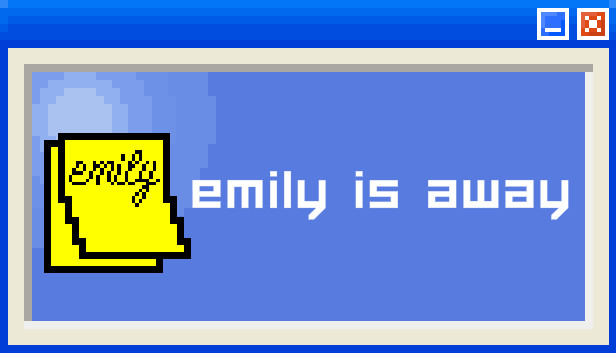Emily is Away (2015)
The game begins in 2002, during the protagonist’s final year of high school. The user, who can choose their own name and screen name, logs into a nostalgic chat client, complete with old-school avatars, buddy icons, and away messages that mirror early-2000s trends. Popular culture references abound—lyrics from blink-182 or Eminem songs, Matrix avatars, and cryptic AIM away messages. It’s a time of youthful optimism, awkward crushes, and the final stretch before adulthood.
The protagonist’s main focus is Emily—or “emilyluv” or “emerly,” depending on her screen name. She’s a close friend, possibly more, and their conversations carry that unspoken weight of something that could be. They chat about the end of high school, their hopes for college, and the social politics of teenage life.
One major subject of conversation is a classmate named Brad, who’s been messaging Emily frequently, clearly interested in her. Another is a party being thrown by Travis that very night—a decision point for the player. Do they say they’ll go to the party? Do they encourage Emily to go? The answers won’t just affect the night; they will ripple through the next several years.
As Emily logs off, the player is left with a mixture of anticipation and uncertainty. Whatever choice they’ve made—whether they attended the party or not—will set the stage for the emotional rollercoaster to come.
By 2003, the player has graduated and entered their freshman year of college. Logging into the now-familiar chat client, they find that Emily is online again. Her screen name and away message have changed, reflecting a shift in mood and personality. Their conversation reveals that Emily is now in a relationship—either with Brad or Travis, depending on the events of the party in 2002. But her tone hints at cracks in the relationship. She says things are “okay,” but not with conviction. The player character congratulates her, masking any disappointment they may feel, and shifts the conversation to neutral topics like classes and dorm life.
Their dynamic has changed. There’s still a connection, but now it feels more distant, more restrained. The conversation ends as Emily logs off, the air thick with unspoken words.
By 2004, the player was in their second year of college. When Emily comes online, she reveals that her relationship has ended. She explains they “grew apart,” a phrase that’s both vague and final. The player is given the opportunity to comfort her, offering words of support or choosing a more reserved path. This moment becomes a crossroads. Depending on prior decisions, Emily might ask the player why they didn’t attend Travis’s party back in 2002—or if they did, why they didn’t kiss her. There’s a lingering “what if?” that haunts the conversation, a realization that timing and decisions have kept them apart.
Emily then floats a question: Can she come visit?
It’s an emotionally loaded request. If the player agrees, they cancel plans with a close friend named Emma. If they decline, they risk closing a door that may never open again. Most players choose to let Emily visit, hoping for closure, or maybe something more.
When 2005 rolls around, everything is different. The visit has already happened, and its aftermath looms heavily over their next chat. Emily wants to talk about what occurred. Depending on how the visit went, the conversation changes dramatically.
If the player didn’t establish clear boundaries, it’s revealed that they and Emily hooked up during the visit. What seemed like a moment of emotional closeness now feels murky. Emily expresses regret, saying she felt vulnerable and that the encounter made her uncomfortable. The protagonist might have seen it as a turning point; she saw it as a mistake.
Alternatively, if the player set boundaries and refrained from intimacy, Emily questions why nothing happened. Did the player have feelings for her? If so, why didn’t they act? The tension is palpable. The visit, regardless of outcome, did not bring them closer—it pushed them further apart.
There’s also a third route: if the player declined the visit altogether, the chat is awkward and superficial. Emily asks about new friends, makes small talk, and then logs off. It’s clear she’s emotionally distancing herself, unsure of how to bridge the growing chasm between them.
By the final year of college in 2006, the once-close bond is now little more than a memory. Emily logs on, but the warmth is gone. She talks about how much better her life is now. She’s back with Brad or Travis. She has a new life, new priorities. The player, meanwhile, might have lost touch with Emma—a consequence of prioritizing Emily the previous year.
Their final conversation is marked by emotional withdrawal. The protagonist starts typing messages full of vulnerability—asking if things will ever be the same, confessing their lingering feelings—but they delete them before sending. Instead, they ask about the weather or her classes. It’s a masterstroke of the game’s writing: the player sees what the character wants to say, only for it to be erased in favor of banal conversation.
And then, the final twist. For the first time in the game, the player is the one who logs off first.
Alternatively, if the player avoided the emotional confrontation in 2005, Emily refuses to talk at all in 2006. She sends a quick message saying she’s too busy to chat. There is no goodbye, no closure. Just silence.
#WeTakeAStand #OpinYon #OpinYonNews #GamersGuide #EmilyIsAway
